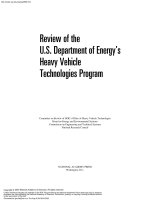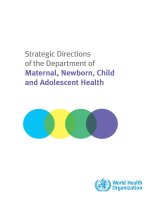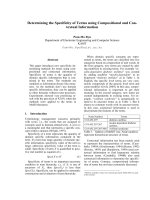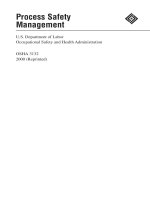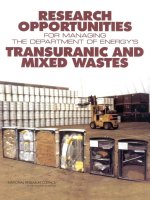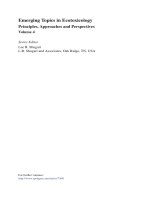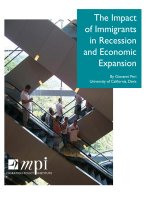Acknowledgements The Department of the Environment, Heritage and Local Government ppt
Bạn đang xem bản rút gọn của tài liệu. Xem và tải ngay bản đầy đủ của tài liệu tại đây (777.35 KB, 119 trang )
Planning Guidelines
Acknowledgements
The Department of the Environment, Heritage and Local
Government wish to acknowledge the following persons and
organisations who assisted in the revision of these guidelines: -
Sustainable Energy Ireland
An Bord Pleanála.
Cork County Council.
Geological Survey of Ireland.
Irish Aviation Authority
Dr Eric R Farrell, Trinity College, Dublin
Planning Guidelines
Planning Guidelines
Contents
Page No
Chapter 1 Introduction and Policy Context 1
1.1 Purpose and Status of Guidelines 1
1.2 Policy Context 1
Chapter 2 Technology and Wind Energy
Development 6
2.1 Technology 6
2.2 Size and Scale of Wind Turbines
and Wind Energy Developments 8
Chapter 3 Wind Energy and the Development Plan 9
3.1 Introduction 9
3.2 Relevant National and Regional
Policy Documents 9
3.3 Consultation 9
3.4 Development Plan - Strategic
Aims and Objectives 10
3.5 Step-by-Step Guide to the
Analysis of Suitable Areas for
Wind Energy by the
Planning Authority 11
3.6 Geographical Information
Systems and Wind Energy
Development 13
3.7 Natural and Built Heritage
and Wind Energy Development 14
3.8 Amenity Designations 14
3.9 Tourism and Recreation 14
Chapter 4 Planning Applications and
Environmental Impact Assessment 16
4.1 Pre-Application Consultation 16
4.2 Wind Measuring Masts 17
4.3 Access to the Electricity Grid 17
4.4 Public Consultation with the
Local Community 19
Planning Guidelines
4.5 General Considerations in the
Assessment of Wind Energy
Planning Applications 20
4.6 Need for an Environmental
Impact Assessment 21
4.7 Sub-EIA Threshold Developments 22
Chapter 5 Environmental Implications 23
5.1 Introduction 23
5.2 Natural Heritage 23
5.3 Ground Conditions/Geology 26
5.4 Archaeology 28
5.5 Architectural Heritage 28
5.6 Noise 28
5.7 Safety Aspects 31
5.8 Proximity to Roads and Railways 31
5.9 Proximity to Power Lines 31
5.10 Interference with
Communications Systems 32
5.11 Aircraft Safety 32
5.12 Shadow Flicker 33
5.13 Windtake 34
5.14 Decommissioning and
Reinstatement 34
Chapter 6 Aesthetic Considerations in Siting
and Design 35
6.1 Introduction 35
6.2 Aesthetic Considerations 36
6.3 Siting of Wind Energy
Developments 37
6.4 Spatial Extent and Scale 40
6.5 Cumulative Effect 41
6.6 Spacing 42
6.7 Layout 43
6.8 Height 45
6.9 Landscape Character Types
as a Basis for Guidelines 46
6.10 Landscape Impact of Wind
Energy Development
Construction 70
6.11 Landscape Impact of Associated
Development 71
6.11.1 Control Building and
Substation Compound 71
6.11.2 Fencing 72
Planning Guidelines
6.11.3 Connection to Electricity
Providers 72
6.11.4 Roads/Tracks 73
6.12 Turbine Colour 75
6.13 Turbine Maintenance 75
6.14 Turbine Transformers 76
6.15 Landscape Impact of
Wind Energy Development
Operation and Decommissioning 76
6.16 Estimation of the Likely
Degree of Impact on Landscape 76
Chapter 7 Planning Conditions 79
7.1 Introduction 79
7.2 Siting Design 80
7.3 Flexibility in Turbine Location 80
7.4 Archaeology 81
7.5 Noise, including Construction
Noise 81
7.6 Environmental Impact:
Mitigation/Compensatory
Measures 82
7.7 Environmental Monitoring 82
7.8 Construction Phase 83
7.9 Borrow Pits and Quarrying 83
7.10 Roads and Access Tracks 84
7.11 Ancillary Structures and
Equipment 84
7.12 Connection to Electricity
Distributors 84
7.13 Site Management Issues 85
7.14 Shadow Flicker 85
7.15 Electromagnetic Interference 85
7.16 Aeronautical Safety 85
7.17 Windtake 86
7.18 Development Contributions 86
7.19 Decommissioning and
Reinstatement 87
7.20 Time Limits 87
Planning Guidelines
Appendices
Appendix 1 Landscape Sensitivity Analysis
Methodology 88
Appendix 2 Advice for Developers on Best Practice
in the Pre-application Consultation
Process 91
Appendix 3 Landscape Impact Assessment of Wind
Energy Development Proposals 93
Appendix 4 Best Practice for Wind Energy
Development in Peatlands 99
Appendix 5 Glossary 102
Appendix 6 References 108
1
Planning Guidelines
Chapter 1
Introduction and Policy Context
1.1 Purpose and Status of Guidelines
These Guidelines offer advice to planning authorities on planning
for wind energy through the development plan process and in
determining applications for planning permission. The guidelines
are also intended to ensure a consistency of approach throughout
the country in the identification of suitable locations for wind
energy development and the treatment of planning applications
for wind energy developments. They should also be of assistance
to developers and the wider public in considering wind energy
development.
The Department originally issued guidelines in September 1996
to planning authorities on wind energy development. These
guidelines supersede the 1996 guidelines and are one of a series
of guidelines aimed at assisting planning authorities in the exercise
of their functions.
The Minister of the Environment, Heritage and Local Government
issues these guidelines under Section 28 of the Planning and
Development Act, 2000, which requires both planning authorities
and An Bord Pleanála to have regard to them in the performance
of their functions. Planning authorities are also required under
Section 28 to make copies of the guidelines available for inspection
by members of the public. It should, however be noted that these
guidelines relate solely to land use and environmental issues
related to on-shore wind energy and do not deal with issues
concerning purchasing agreements, matters relating to grid capacity
or off-shore wind energy.
Offshore wind farms are excluded from the provisions of the
Planning & Development Act 2000. They are, however, subject to
the Foreshore Acts which are administered by the Minister for
Communications Marine and Natural Resources. That Departments
procedures can be seen in the booklet "Offshore Generating Stations
2
Planning Guidelines
- Notes for Intending Developers which is available free from the
Department or may be downloaded from the Department's website
at: www.dcmnr.gov.ie.
1.2 Policy Context
The development of renewable energy sources, together with
measures aimed at a reduction and more efficient use of energy,
are priorities, nationally and at European level, on both
environmental and energy policy grounds. The implementation
of renewable energy policies must also have regard for the
environment. Specifically, there is a legal requirement to integrate
the conservation and sustainable use of biological diversity, manifest
in Ireland’s ratification of the Convention on Biological Diversity
and the binding requirements of the EU Directives on Birds and
Habitats, into all sectoral guidance, plans and policies.
The government has to date supported the development of
renewable energy-based electricity generating plant including
wind turbine generators, mainly through the administration of
competitions under the Alternative Energy Requirement
Programme, which gave wind energy companies a guaranteed
market to sell power.
The need to fulfil Ireland’s national and international commitments
to renewable energy, and the acknowledged quality of the Irish
wind energy resources is expected to lead to continued growth in
wind energy developments. The Department of Communications,
Marine and Natural Resources is currently undertaking a review
of options for future renewable energy policy targets and
programmes. The review will consider indicative increases in
Ireland’s green energy output between now and 2020.
1.2.1 The National Development Plan (2000-2006)
The National Development Plan provides support under the
Economic and Social Infrastructure Operational Programme, for
the promotion of alternative energy. In this regard, expansion of
the use of renewable energy and promotion of the development
of technology, which contributes to meeting our international
climate change obligations, are prime objectives.
3
Planning Guidelines
1.2.2 Sustainable Development: A Strategy for Ireland (1997)
The key sustainable energy policy is the reduction in and more
efficient use of energy and also the greater use of renewable energy
in order to significantly reduce environmental degradation and
contribute to mitigating global problems such as climate change.
1.2.3. EU White paper on Renewable Energy (1997)
This paper identified a potential growth in the contribution of
renewable energy to total energy supply from 14.3% to 23.5% by
2010. Consequently, Directive 2001/77/EC of September 2001 on
the promotion of electricity from renewable sources in the internal
electricity market
1
addresses an obligation on Member States to
establish a programme to increase the gross consumption of
renewable energy-based electricity generating plant (“green
electricity”). The indicative target addressed to Ireland in the
Directive is to increase green electricity from 3.6% of gross electricity
consumption in 1997 to 13.2% by 2010.
1.2.4 Green Paper on Sustainable Energy (1999)
This paper set a target of increasing the percentage of electricity
generated by renewable sources from 6.3% in 2000 to 12.39% in
2005, which will be achieved by the installation of an additional
500 MW from renewable energy sources by 2005, mainly from
wind energy. Following on from the Green Paper, the main aim
of the Strategy for Intensifying Wind Energy Deployment (July
2000) is to support the delivery of this 500 MW target of renewable
energy-based electricity generating plant.
1.2.5 The Electricity Regulation Act 1999
The Electricity Regulation Act, 1999, provided for the commencing
of the liberalisation of the electricity market to competition in line
with the requirements of the EU electricity and Competition
Directives.
1.2.6 National Climate Change Strategy (2000)
International action to address the global problem of climate change
led to the adoption of the 1997 Kyoto Protocol to the United Nations
1
The Renewable Energy Directive.
4
Planning Guidelines
Framework Convention on Climate Change. The Government’s National
Climate Change Strategy sets out a ten year policy framework for
achieving the necessary greenhouse gas reductions towards Ireland’s
compliance with its 13% limitation target on 1990 emissions, within
the overall EU reduction target of 8%, by the first commitment
period 2008-2012. In addition to taking action now to reach this
first step target, further action will be required to meet deeper
level commitments. The scientific consensus developed in the
Intergovernmental Panel on Climate Change is that cuts in global
emissions of 60-70% over the century are needed to stabilise
greenhouse gas levels in the atmosphere at concentrations that
prevent dangerous human-induced impacts on global climate
systems.
1.2.7 Habitats & Birds Directives
The EU Directive (92/43/EEC) on the Conservation of Natural
Habitats and of Wild Flora and Fauna
2
requires Ireland to propose
relevant areas for designation as Special Areas of Conservation
for the conservation of listed habitats and species, and to maintain
their favourable conservation status. The Habitats Directive was
transposed into Irish law by The European Communities (Natural
Habitats) Regulations, 1997 (S.I. 94 of 1997).
The EU Directive 79/409/EEC on the Conservation of Wild Birds
3
,
requires that special measures be taken to conserve the habitats
of listed migratory and wetland species in order to ensure their
survival and reproduction in their area of distribution. The most
suitable areas for these species are classified as Special Protection
Areas. Ireland is obliged to “take appropriate steps to avoid
pollution or deterioration of habitats or any disturbances affecting
the birds”. Only activities that do not have significant effects on
birds are acceptable in Special Protection Areas. The Birds Directive
also requires the avoidance of pollution or deterioration of habitats
generally outside specifically protected sites. A listing of Special
Areas of Conservation and Special Protection Area sites is available
at www.heritagedata.ie.
2
The Habitats Directive
3
The Birds Directive
5
Planning Guidelines
1.2.8 Convention on Biological Diversity and National
Biodiversity Plan (2002)
The National Biodiversity Plan 2002 was prepared in response to
Article 6 of the Convention on Biological Diversity. This plan “pays
special attention to the need for the integration of the conservation
and sustainable use of biological diversity into all relevant sectors.
The full and effective integration of biodiversity concerns into the
development and implementation of other policies legislation and
programmes is of crucial importance if the conservation and
sustainable use of biodiversity is to be achieved”.
1.2.9 Making Ireland's Development Sustainable (2002)
Making Ireland's Development Sustainable was produced by the
Department of the Environment, Heritage and Local Government
for the Johannesburg World Summit on Sustainable Development
held in 2002. The report examines progress made in the ten years
since the Rio de Janeiro Earth Summit, assesses the challenge we
now face, and sets out policies and actions to meet that challenge.
It concludes that a high quality environment is essential for
economic progress and for sustainable development generally.
6
Planning Guidelines
Chapter 2
Technology and Wind Energy
Development
2.1 Technology
Wind turbines are used to convert the wind’s kinetic energy to
electricity. Wind energy proposals may be for single turbines or
for groupings of turbines (wind energy development). Planning
authorities should be aware that wind turbine technology is
continually changing.
A wind turbine will generally include the following elements(see
diagram 2.2)
Fig 2.2
Tower: (A) Currently may vary in height from 35 metres upwards.
Tubular steel towers typically have a base diameter of 3-7 metres
and display a slight tapering to the nacelle. Larger towers may
require a larger base diameter.
C
B
A
D
7
Planning Guidelines
Nacelle: (B) This contains the key mechanical components of the
wind turbine including the gearbox and generator. A yaw
mechanism is employed to turn the nacelle so that the rotor blades
face the prevailing wind.
Blades: (C) The blades, which capture and are set in motion by
the wind, are most commonly made of glass reinforced plastic or
wood epoxy but can be made of aluminium or steel. Modern
turbines typically have three blades. These may vary in rotor
diameter from 35 metres upwards.
Transformer: (D) This is a device for changing the voltage of the
alternating current. Electricity is typically generated at less than
1000 volts by the wind turbine and the transformer “steps up”
this voltage to match that of the national grid. This may be housed
either inside or alongside the tower.
Concrete foundation bases: Turbines typically have bases of
between 7 and 18 metres square and a hardstanding area at the
base of each turbine.
A typical wind energy development may include the following
elements:
Wind turbines
Wind monitoring mast
Transformers Serving each turbine.
Internal tracks Giving access to the turbines.
Substation compound Including transformers, circuit
breakers and control building
Power cables Usually underground within the
site.
Poles/pylons Connecting wind energy
development site to the national
grid
8
Planning Guidelines
2.2 Size and Scale of Wind Turbines and
Wind Farms
Wind turbines can be deployed singly, in small groups or in larger
numbers in wind energy developments. Various factors may
influence the size of a wind energy development, including technical
issues relating to the physical nature of the site, the wind resource
and the capacity of the local transmission or distribution grid, as
well as landscape and heritage considerations and development
plan policies.
9
Planning Guidelines
Chapter 3
Wind Energy and the
Development Plan
3.1 Introduction
It is important that all development plans incorporate both a
statement of the planning authority’s policies and objectives in
relation to wind energy development and matters it will take into
account in assessing planning applications for specific wind energy
development proposals.
The development plan must achieve a reasonable balance between
responding to overall Government Policy on renewable energy
and enabling the wind energy resources of the planning authority’s
area to be harnessed in a manner that is consistent with proper
planning and sustainable development.
The assessment of individual wind energy development proposals
needs to be conducted within the context of a “plan-led” approach.
This involves identifying areas considered suitable or unsuitable
for wind energy development. These areas should then be set out
in the development plan in order to provide clarity for developers,
the planning authority, and the public.
3.2 Relevant National and Regional Policy
Documents
Important documents to be considered by planning authorities in
the context of preparing and adopting strategic policies and
objectives in relation to wind energy development in their
development plans include all relevant Ministerial planning
guidelines and guidance notes.
3.3 Consultation
Planning authorities are required to consult appropriate bodies
to ensure that development plan policies have regard to relevant
10
Planning Guidelines
considerations, policies and views (Section 11(3)(c) of Planning and
Development Act, 2000). In the context of wind energy development,
this will include the Department of Communications, Marine and
Natural Resources, the Department of Environment, Heritage and
Local Government, in terms of the natural and built heritage, and
electricity providers. In addition to the above, it is advisable to
consult with Sustainable Energy Ireland, recreational and tourism
bodies, and other heritage organisations as deemed appropriate.
3.4 Development Plan – Strategic Aims and
Objectives
Following consideration of the strategic context in regional and
national terms for wind energy development, and also after full
consultation with the appropriate bodies, the development plan
should set out the following policies and objectives:
• a positive and supportive statement of the importance of
wind energy as a renewable energy source which can play
a vital role in achieving national targets in relation to
reductions in fossil fuel dependency and therefore
greenhouse gas emissions, together with an objective to
ensure the security of energy supply;
• objectives to secure the maximum potential from the wind
energy resources of the planning authority’s area
commensurate with supporting development that is
consistent with proper planning and sustainable
development;
• the identification on development plan maps of the key
areas within the planning authority’s functional area where
there is significant wind energy potential and where, subject
to criteria such as design and landscape planning, natural
heritage, environmental and amenity considerations, wind
energy development will be acceptable in principle;
• the specific criteria for wind energy development that the
planning authority will take into account when considering
any wind energy or related
4
proposals in the key areas
4
These may include energy networks and temporary wind anemometers
that measure wind potential.
11
Planning Guidelines
identified, based on the recommended siting and design
criteria referred to in these guidelines. Wind energy project
developers, the public and other interested parties require
a clear framework to indicate where wind energy
development should locate, and what factors will be taken
into consideration in dealing with such proposals; and
• the investigation of the potential for relatively small-scale
wind energy developments within urban and industrial
areas, and for small community-based proposals outside
the key areas that are identified as being appropriate for
wind energy development. Community ownership of wind
energy projects enables local communities to benefit directly
from local wind energy resources being developed in their
local areas, ensuring long-term income for rural
communities.
3.5 Step-by-Step Guide to the Analysis of
Suitable areas for Wind Energy by the
Planning Authority
In order to assist planning authorities to identify, on development
plan maps, key areas where there are good wind energy resources
capable of exploitation in a manner consistent with proper planning
and sustainable development, a step-by-step approach is proposed.
This ordered approach involves a sieve mapping analysis of the
key environmental, landscape, technical and economic criteria
which must be balanced in order to identify the most suitable
location for wind energy development. In carrying out this exercise,
it is advised to consult with neighbouring planning authorities to
ensure a consistent approach across county boundaries. The
methodology for this approach is outlined in the following
paragraphs.
Step 1
Assess the areas of wind potential ranging from areas with extensive
wind energy resources to lesser wind resources using Sustainable
Energy Ireland’s Wind Atlas for Ireland. The Wind Atlas for Ireland
displays wind speeds at 50 metres, 75 metres and 100 metres above
ground level. The three heights represent the hub heights of current
12
Planning Guidelines
and near-future wind turbine technology. Assistance in this regard
can be obtained from Sustainable Energy Ireland’s Renewable
Energy Information Office in Cork (tel: 023-42193, e-mail:
).
Step 2
Prepare or utilise an evaluation of the landscape and its sensitivity
for wind energy developments. Factors that can inform landscape
sensitivity to wind energy development, include scenic quality,
rarity, uniqueness and natural and cultural heritage considerations.
(Some local authorities have prepared landscape characterisation
maps, which could support this process). A methodology for
landscape sensitivity mapping is outlined at Appendix 1.
Step 3
Prepare an overlay of the landscape evaluation and sensitivity
analysis, and sensitivity and wind energy mapping, together with
information regarding built and natural heritage, archaeological
and amenity designations in the Development Plan. This will
identify those areas affected by statutory obligations and will
facilitate optimising visual integration into the landscape while
at the same time maximising the utilisation of wind energy
resources. The process of overlaying wind energy mapping and
landscape assessment with the development plan designations
will produce a basis for identifying broadly, the areas where wind
energy developments would be ‘acceptable in principle’, where
they would be ‘open for consideration’, and where they would be
‘not normally permissible’.
Step 4
Integrate the areas identified in step 3 with information regarding
accessibility to electricity transmission and distribution grids.
Details of the electricity transmission and distribution network
are provided in Sustainable Energy Ireland’s Wind Atlas for Ireland.
In addition, transmission network details are updated on a yearly
basis in the Transmission System Operator’s Forecast Statement,
available on the internet at www.eirgrid.com. If further network
information is required, it is recommended that the planning
authority consult with the Transmission System Operator (National
Grid) or the Distribution System Operator (ESB Network) as
appropriate.
13
Planning Guidelines
This process will establish, at a general level, areas where wind
energy resources are readily capable of development as well as
identifying other areas where wind energy resources are capable
of being developed but where there is a need for corresponding
development of electricity grid infrastructure.
Regional Planning Guidelines
Many Regional Planning Guidelines propose coordination between
planning authorities in relation to the development of renewable
energy. The sieve analysis approach outlined above would assist
regional authorities in developing a common framework within
and between regions for the development of wind energy.
3.6 Geographical Information Systems
(GIS) and Wind Energy Development
There are particular benefits for planning authorities in using
specialised Geographical Information Systems in wind energy-
related issues. There are three main areas, in particular, in which
planning authorities are encouraged to develop Geographical
Information Systems expertise, viz.:
3.6.1 Identification of Areas
Geographical Information Systems can form an integral part of
policy formulation. It is particularly useful when identifying the
suitability of areas for the deployment of wind energy, given the
amount of information and considerations involved in such an
analysis. Many of the datasets required in an area-based analysis,
such as wind speed information and nature and heritage
designations, are now readily available in Geographical Information
Systems format.
3.6.2 Assessment of Wind Energy Proposals
Planning authorities, where possible, should utilise Geographical
Information Systems software for in-house assessment and
verification of wind energy proposals. The basic models used to
assess wind energy development proposals, such as Zones of
14
Planning Guidelines
Visual Influence and Zones of Theoretical Visibility
5
calculations,
are now an increasingly standard feature of much Geographical
Information Systems software, while integrated links to programmes
producing wireframes and photomontages are commonplace.
Due to the choice and availability of such proprietary software,
these can now be obtained relatively easily and in a cost effective
manner.
3.6.3 Monitoring of Wind Energy Development
Planning authorities, where possible, should set up systems,
incorporating a Geographical Information Systems component,
to monitor wind energy development (including planning
application decisions). This can help review the degree to which
the policies and objectives of the development plan are being
achieved.
3.7 Natural and Built Heritage and Wind
Energy Development
The designation of an area for protection of natural or built heritage
or as an amenity area does not automatically preclude wind energy
development. However, consideration of any wind energy
development in or near these areas must be subject to Ireland’s
obligations under the Habitats Directive (92/43/EEC), the EU
(Birds) Directive (79/409/EEC) and the Environmental Impact
Assessment Directive. Clear guidance on policy and objectives
should be available in development plans on the natural and built
heritage, and the information contained therein on location and
status should be accurate and up-to-date.
3.8 Amenity Designations
The visibility of a proposed wind energy development from
designated views or prospects would not automatically preclude
5
It is felt that the title ”Zone of Theoretical Visibility” is a more accurate
description than “Zone of Visual Influence” – the maps produced are
theor
etical because they estimate exposure of turbines based upon landform
data only and take no account whatsoever of intermittent screening by
vegetation or structures. Furthermore, the maps estimate visibility
of the
turbines in the surrounding landscape and not their “visual influence”.
15
Planning Guidelines
an area from future wind energy development but the inclusion
of such objectives in a development plan is a material factor that
will be taken into consideration in the assessment of a planning
application. Accordingly, such objectives should be up-to-date
and accurate, and reflect the current situation on the ground.
3.9 Tourism and Recreation
The effect of wind energy development on tourism and recreational
activities must be assessed. In this regard, it is desirable that the
relevant regional tourist authority should be consulted. In many
areas in Ireland, tourism and recreation underpin the local economy
and can depend to varying degrees on the quality of the
environment. Wind energy developments are not incompatible
with tourism and leisure interests, but care needs to be taken to
ensure that insensitively sited wind energy developments do not
impact negatively on tourism potential. The results of survey work
indicate that tourism and wind energy can co-exist happily
6
.
The educational potential of wind energy developments should
also be considered. For example, there may be scope for interpretive
centres on alternative energy resources to be located at accessible
locations in proximity to some wind energy developments. It
would be helpful if established long distance walking
routes/amenity rights-of-way were identified and mapped in the
Development Plan. This would enable an assessment both of the
extent to which recreational pursuits can be accommodated and
facilitated either within or adjacent to wind energy developments.
6
Attitudes Towards the Development of Wind Farms in Ireland - Sustainable
Energy Ireland, 2003.
16
Planning Guidelines
Chapter 4
Planning Applications and
Environmental Impact
Assessment
The purpose of this Chapter is to advise planning authorities on
issues that will arise both before and during the planning process.
It includes guidance on pre-planning consultations, grid connections,
public consultation, and the requirements in relation to
environmental impact statements.
4.1 Pre-Application Consultation
7
The primary purpose of consultation is to improve the quality of
a subsequent application, to avoid the necessity for seeking
additional information and in some cases to spare the costs of what
is likely to prove an unsuccessful application.
Consultation can be of value in:
• highlighting development plan objectives on wind energy
as referred to in Chapter 3, and
• suggesting need for specialist input as referred to in Chapters
5 and 6.
It would be helpful if planning authorities maintained an up to
date database for all granted and “built” wind energy developments
including transboundary information where applicable.
To ensure that pre-application consultation is as productive as
possible a developer may be invited to submit a minimum level
of documentation in advance of the meeting. This might include
site location maps, initial description of the development including
7
Section 247 of the Planning and Development Act, 2000, provides that a
person who has interest in land and who intends to make a planning
application may enter into consultations with the planning authority in
order to discuss any proposed development in relation to the land. A
person with no such interest has no statutory entitlement.
17
Planning Guidelines
any initial economic or market factors, sample zones of theoretical
visibility, etc.
It is strongly recommended that the planning authority consult
with the Development Applications Unit of Department of the
Environment, Heritage and Local Government at the earliest
planning and design stages in relation to wind energy developments
that may have a potential impact on the built and natural heritage.
Good research and wide consultation by all parties at the site
selection stage can avoid unnecessary time delays and expense in
considering unsuitable sites.
4.2 Wind Measuring Masts
Planning applications for wind anemometers and measuring masts
are generally sought for a limited period only. Permissions should
be granted for approximately a two-year period, in consultation
with the developer, to allow a wind resource analysis to be carried
out. It would be inadvisable for the planning authority to grant
planning permission for a wind measuring mast in an area where
there is a presumption against wind energy development in the
development plan. In a case where a developer wishes to extend
the period of the permission an application must be made to the
planning authority to retain the wind measuring mast; otherwise
the developer should be required to remove it.
4.3 Access to the Electricity Grid
In addition to consultation with planning authorities and statutory
bodies, wind energy developers should consult with the relevant
electricity transmission or distribution grid operators who have
responsibility for access to the local grid system in relation to the
nature and location of proposed grid connections.
Where the works required to connect the wind energy development
to the local electricity transmission/distribution network are not
exempt, it will be necessary to submit a planning application to
the planning authority. Best practice would suggest that an
integrated planning application that combines grid interconnection
information together with details of the wind energy development
18
Planning Guidelines
should be submitted to the planning authority. However, if this
is not possible, then the planning authority should agree in advance
with the developer the information on the grid connection that
they consider necessary to enable them to fully assess a planning
application for the wind energy project, and which the developer
is in a position to furnish.
Details of indicative and feasible options for grid interconnection
lines and facilities should in general be adequate for a planning
authority to consider a wind energy application as the precise
capacity required for connection will not be known until planning
permission is obtained. Suggested content for these indicative and
feasible options include (a) the general direction of connection,
(b) connecting line capacity (e.g. 38 kV, 110 kV) and (c) line
supporting structure (e.g. single pole, twin pole, lattice tower).
The planning authority should note that it may not be possible,
due to reasons outside the applicant’s control, to provide
information on indicative grid connections at the pre-planning
consultation or planning application stage of the wind energy
development.
It is therefore inappropriate for the planning authority or An Bord
Pleanála on appeal to attach conditions to planning permissions
for wind energy developments in regard to the location of the
connection to the grid. In these instances, a separate application
for the grid connection will be necessary.
However, where such information is available and is submitted
as part of a planning application, it would be appropriate, if
considered necessary, to attached conditions in regard to the grid
connection.
In order to minimize project development risks and to ensure
appropriate grid infrastructure which takes account of potential
impact on the built or natural heritage, wind energy developers
and electricity companies should consult with the planning authority
and with the Development Applications Unit of the Department
of Environment, Heritage and Local Government in regard to the
submission of a separate application for a grid connection.
19
Planning Guidelines
4.4 Public Consultation with the Local
Community
Planning authorities should encourage developers to engage in
public consultation with the local community. While it is not a
mandatory requirement, it is strongly recommended that the
developer of a wind energy project should engage in active
consultation and dialogue with the local community at an early
stage in the planning process, ideally prior to submitting a planning
application.
The developer should work with the local community on the
format of any future consultation to allow for the free flow of
information between the community and the wind energy developer
at all stages in the project. Consultation should be meaningful and
should give the local community an opportunity to comment upon
and to have an input into the planning and design of the scheme.
It may be helpful to put formal procedures in place to deal with
queries and complaints from the general public.
In accordance with best practice the developer should appoint an
individual to be accessible to the local community from the
construction to the commission stages to allow for dialogue and
communication and to keep the public informed about the progress
of the project. A lo-call number for further contact thereafter may
also be appropriate. It may also be worth considering providing
an opportunity for residents of areas in which it is proposed to
develop a wind energy project to invest in the scheme, particularly
Typical MediumVoltage (10kV or 20kV) line.
Wayleave clearance required but not
planning permission, except in particular
circumstances.
Typical (38kV) line.
Requires wayleave and planning
permission.

